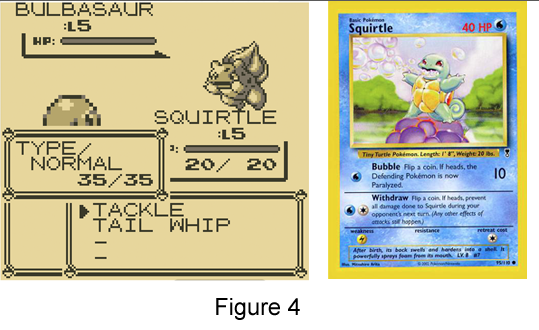by Alberto D’Onofrio (6328849)
I was eight-years-old when my parents first purchased me a Game Boy Color and Pokemon Red, about two-years after their initial release. I remember being hooked, which spawned my interest and consumption in the “Pokemon supersystem”: their anime, trading cards, toys, movies and soundtracks. This is an example of an audience’s interaction with media, which is defined as “convergence culture” by media theorists such as Thomas Apperley in “Citizenship and Consumption: Convergence Culture, Transmedia Narratives and the Digital Divide”. Apperley acknowledges the work of theorist Marsha Kinder who is credited of coining the term “transmedia” (Johnson), a storytelling tactic that involves a reliance on “corporate synergies”, as Apperley explains, where media artifacts such as movies (theorist Henry Jenkin’s example of The Matrix) or video games (Pokemon Red) invite a “co-operation between media industries through conglomeration, partnerships and licensing” (Apperley 1). Having the opportunity to play Pokemon Red with a critical mindset after reading Apperley’s examination of convergence culture through Marsha Kinder’s framework on transmedia, I examined the aspects of Pokemon Red that allowed an alliance with the supersystem.
“At the game screen the players constructed as ‘consumerist subjects who can more readily assimilate and accommodate whatever objects they encounter’ [8]. This videogames: ‘help prepare young players for full participation in this new age of interactive multimedia – specifically, by linking interactivity with consumerism’.
(Apperley 1)
I revisited Pokemon Red with Apperley’s quote above, from Kinder’s analysis on transmedia, in mind. To summarize, the objects, characters, and/or aspects of the game we encounter offer a use in anime, trading cards, toys, movies and soundtracks which are all part of the Nintento (the game’s manufacturer) and Pokemon supersystem. The following are elements of Pokemon Red that I encountered that transcends onto other products:
- At the beginning of the game, Ash, the main character, is in his room. The player is able to navigate within the space, where a television and a console is placed in the middle. When interacting with this, the game screen narrates “ASH is playing the SNES!” – a product of Nintendo. (Figure 1)
- The main characters, supporting characters, objectives of the game, and surroundings in Pokemon Red are utilized in the anime television show that inspired a partnership with media corporations outside of Nintendo, such as the studio OLM, Inc and Networks TV Tokyo, Cartoon Network, YTV and Teletoon, to name a few (imdb). The similarities between the game and the television show, Pokemon anime (Yuyama 1997) that was produced upon the game’s success is an example of helping “young players fully participate in a new age of multimedia” (Apperley 1); young audiences are already familiar from the first episode of the Pokemon anime because they have already encountered its elements in Pokemon Red. For instance, the opening introduction of the game (Figure 2), the items of the Pokedex and Pokeballs, the characters Ash, Gary, Professor Oak, the Gym Leaders and of course, the Pokemon creatures. In addition, the setting is the same, with the use of Pallet Town, and the television show’s opening lyrics represent the goal of the game: “I want to be the very best, Like no one ever was,To catch them is my real test, To train them is my cause”. These elements continued further to feature films, such as the first Pokemon: The Movie (Yuyama, 1998), from the result of a synergy between Pokemon, OLM, Inc., Toho and Warner Bros. Pictures (imdb) that also featured movie soundtrack products.
- The Pokedex, Pokeball and Pokemon creatures are not only an element found in the game and television show, but part of the many toy products that offered relationships between Nintendo and corporate toy companies (Figure 3).
- The gameplay element in Pokemon Red was implemented onto Pokemon Trading Cards, part of Pokemon relationship with trading-card-making company Wizards of the Coast. The gameplay in Pokemon Red is similar to the trading-card game where each Pokemon had it own card with unique attacks (Figure 4).
There is a clear familiarity between Pokemon Red and the products and media artifacts that spawned from it. It outlines the objective of transmedia that Marsha Kinder outlines. Thomas Apperley expands on this with the new potential the internet and the audience’s own usage of media. For instance, there are various fan-made movies and trailers of Pokemon showcased on Youtube, like “Pokemon Apokelypes” (link in “works cited”). As Apperley outlines from communication theorist Henry Jenkin’s, “In a hunting culture, kids played with bows and arrows. In an information society, they play with information” (Apperley 2). The children that played Pokemon Red grew up in an information age that lead to their involvement and usage of technology.
In addition, Apperley suggests that the impact of transmedia relies on how far a certain country is developed in the digital age in order to have access to this media. For instance, Apperley examines that countries like Venezuela have less access to this media and this makes it difficult for their audience to interact with transmedia products (Apperley 2). I researched into Pokemon’s status in Venezuela, and a found a Venezuelan Facebook page dedicated to Pokemon. It’s fan-following includes roughly 2000 people, not a significant number, but more than what I expected after reading Apperley’s article. However, this is eight years after Apperley wrote the article in 2007. The internet has great changed in eight years and perhaps this is an indication of Apperley’s suggestion that “the internet in particular is used to underscore the new potentials of this shift” (Apperley 1).
In conclusion, Thomas Apperley outlines the impact that transmedia artifacts can have with synergies between corporate companies in order produce additional products and multimedia. Pokemon Red is an example of this, by using its familiar components in media and products such as anime, trading cards, toys, movies and soundtracks. With the driving force of the Internet, I envision a growing worldwide interaction with the product for years to come.
Works Cited:
Apperley, Thomas. “Citizenship and Consumption: Convergence Culture, Transmedia Narratives and the Digital Divide.” IE ’07 Proceedings of the 4th Australasian conference on Interactive entertainment. Eds. Martin Gibbs and Yusuf Pisan. RMIT University, Melbourne, Australia, 2007.
Johnson, Derek. “Spreadable Media.” Spreadable Media A History of Transmedia Entertainment Comments. N.p., 17 Dec. 2012. Web. 19 Mar. 2015. <http://spreadablemedia.org/essays/johnson/#.VQsB9SiU9UM>
“Pokémon.” IMDb. IMDb.com, n.d. Web. 19 Mar. 2015. <http://www.imdb.com/title/tt0176385/>.
Pokemon (anime). Dir. Kunihiko Yuyama. OLM Inc. 1997-present.
Pokemon Apokelypes. Dir. Lee Majdoub. https://www.youtube.com/watch?v=sDX1m0Y2Vkg.
Pokémon Red Version. Nintendo, 1998. Game Boy.
Pokémon: The First Movie. Dir. Kunihiko Yuyama. OLM Inc, Warner Bros. Pictures. 1998.
“Pokémon: The First Movie.” IMDb. IMDb.com, n.d. Web. 17 Mar. 2015. <http://www.imdb.com/title/tt0190641/>.




